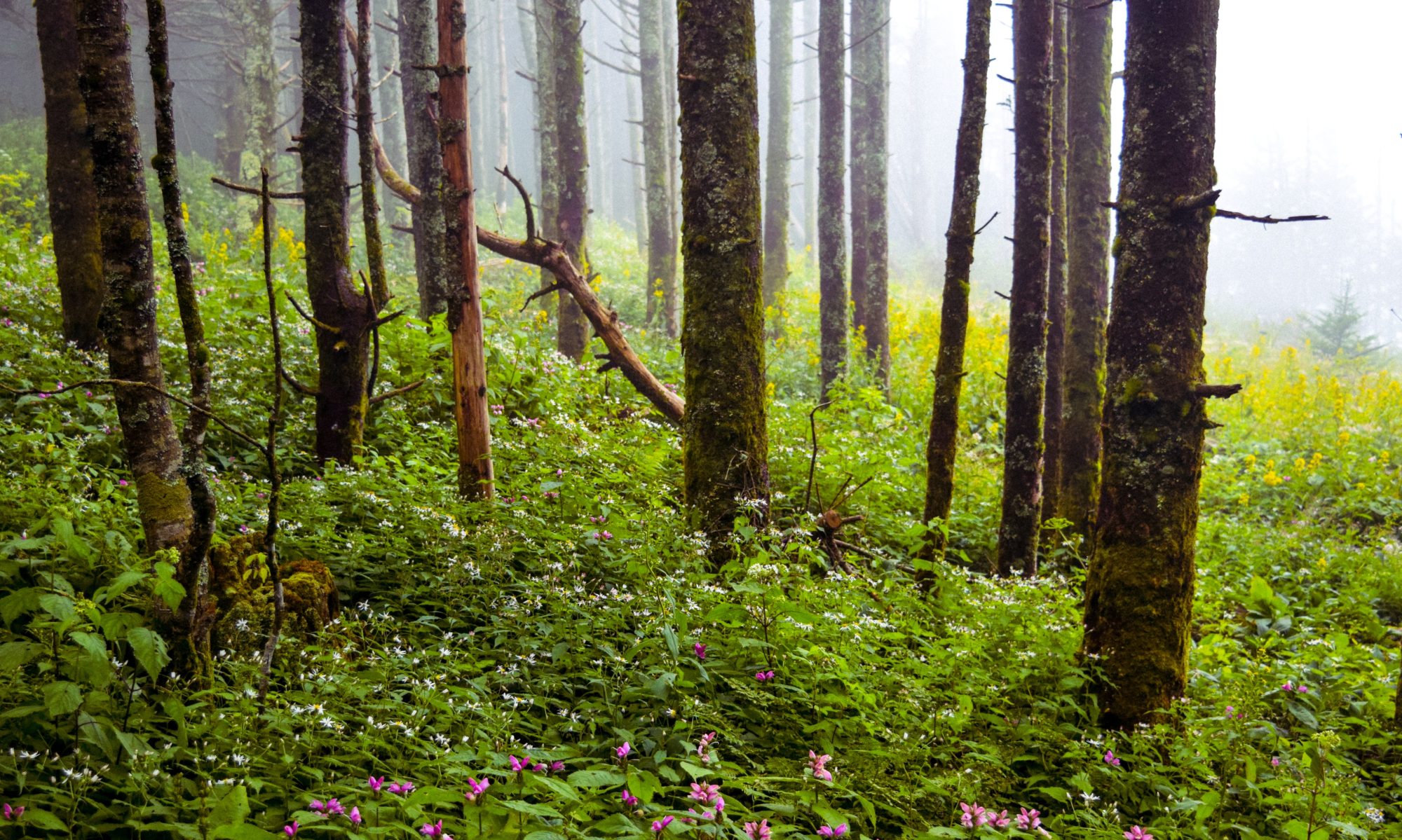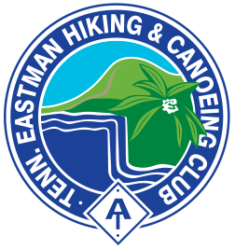During 2000-2001, the A.T. on Round Bald was relocated and rehabilitated, to eliminate significant erosion problems and replace the former steep route with a more gradual sidehill trail. The project has three distinct phases:
- Phase 1 – Gravel delivery and trail construction from Carvers Gap to a large rock about two-thirds of the way up to the summit of Round Bald – summer of 2000.
- Phase 2 – Gravel delivery between the large rock and Engine Gap – February-March 2001.
- Phase 3 – Spreading the gravel on the existing Trail route between the large rock and Engine Gap – summer of 2001.
Phase 1 (Now “Stairway to Heaven” is only a song)
The summer of 2000 marked the completion of the first phase of one of the more unusual and involved projects undertaken along the Appalachian Trail. The Konnarock Volunteer Trail Crew and the Tennessee Eastman Hiking Club (TEHC) opened the first section of a Trail relocation and rehabilitation project in the Roan Mountain area. Over the course of three weeks this summer, most of the steps leading steeply from the parking area at Carvers Gap to the first summit, Round Bald, were replaced with a more gradual sidehill trail. The quarter-mile distance to a large rock providing a vantage point was roughly doubled by this relocation.
Well, what’s so unusual about a half-mile sidehill Trail relocation? The three weeks of actual construction was a drop in the bucket, compared to the years that TEHC, ATC, and the Forest Service worked for approval of this relocation. The section that was to be replaced was constructed by a crew from the Appalachian Mountain Club of New Hampshire in 1976. That crew built steps most of the way up 5,826-foot Round Bald. The steps were stable, but many hikers in this high-use, open area walked off the Trail onto the grassy bald, forming ditches. The high use, the soft organic soils, and the heavy precipitation in the area all contributed to serious erosion problems. Even with filling in the eroded areas, the Trail partners felt that hikers would continue to wander off the steep steps, and the erosion problems would persist and worsen.
A Trail relocation was called for, but it would be far from routine. Konnarock and TEHC had installed a relocation on the back side of Round Bald in 1992, using standard sidehill construction techniques and grades. Within two years, that relocation had become very slick in places and rocky in others. Hikers started walking around that section also, leading to a braided Trail and erosion. In 1995, TEHC hardened an 85-foot section of that relocation, using geotextile to line the treadway with gravel on top. The relocation has held up very well in the ensuing five years. But, that 85-foot section required ten tons of gravel for fill! That gravel was transported to the site using a vehicle resembling a military half-track, with the thinking that it would dig into the soils less than a truck. However, the three trips required to haul the gravel churned up the soil badly, and the entire project was going to require 300 tons of gravel! Driving up the existing A.T. was not an option, because removing the steps would cause massive erosion to occur. Clearly, another way to get the gravel up the bald was needed.
The answer came from the Forest Service in the form of motorized wheelbarrows or “Georgia buggies”. These vehicles have a narrow wheelbase but are still capable of carrying several hundred pounds of gravel per load. The relocation needed to be wide enough to accommodate the heavy hiker traffic, and that width also had to be sufficient for the Georgia buggies. They would be used to build the Trail up from the Carvers Gap parking area where the gravel was staged. Driving subsequent loads over the gravel packed it down, but the surface is still porous enough to allow water to pass through.
Flagging the relocation was also a major challenge. Keeping the Trail in open balds would have required numerous switchbacks, and there was very little vegetation to deter hikers from shortcutting them. Because of the numerous rare species on Round Bald, both in the meadows and adjacent woods where the Trail needed to be routed, it took nearly five years of working with Forest Service biologists, other conservation organizations, and interested naturalists to select a route acceptable to all parties. (A rare tarantula was discovered near the route.)
With a flagline approved and the logistics worked out, the work began in July. For the most part, the actual digging was done using a trackhoe, which cut the path to the proper width while leaving the sod in good shape for reseeding the old A.T., and saved a lot of Konnarock and TEHC effort. The gravel was loaded onto the Georgia buggies, which crew members were trained to operate safely, using a front-end loader provided by TEHC volunteer Frank Oglesby. The geotextile was laid in place, and the gravel was dumped and spread onto it, proceeding uphill. In a few places, turn-outs were built to allow the Georgia buggies to pass without impacting the delicate soils on the bald. Logs from the steps were used to stabilize the gravel on steeper slopes. Many rocks were encountered in the woods, but, through a special rock-cracking device and old-fashioned sledgehammering and prying, they were removed and used for stabilizing the outslope. In wet areas, drains were installed to carry water under the Trail, and, in two especially wet areas, “geoweb” – a thick, synthetic, cellular fabric that enables transport of water through the Trail while providing a stable surface – was used under the normal geotextile and gravel. Fences and replanted vegetation were used to keep hikers on the new Trail and deter the ditch formation that plagued the old Trail. With three weeks of Konnarock-crew assistance, we reached the existing Trail at a large rock about two-thirds of the way up Round Bald. The old Trail below that point was resodded, and the new Trail was opened.
TEHC has received numerous compliments about the relocation. We had feared that hikers would not go into the woods, but that turned out to be one of prettiest parts. Paul Bradley, district manager for the Appalachian Ranger District of the Pisgah National Forest in North Carolina, said, “Hallelujah!” His district and the Nolichucky/Unaka district of the Cherokee National Forest in Tennessee worked for years to get the necessary approvals and addressed a series of resource challenges along the way. Morgan Sommerville, ATC Deep South regional representative, said “It was a long time coming, but worth the wait.”
There is still much to be done in this area. TEHC is working on a relocation on the other side of the road at Carvers Gap, and a major relocation is planned to descend Grassy Ridge, which also has become very eroded. Finishing the Round Bald relocation/rehab to Engine Gap will be a challenge. The work slowed down considerably as the distance from Carvers Gap grew, and logistics may necessitate a helicopter for delivery of gravel in the future.
During the three-week project, TEHC had 42 volunteers who worked more than 1,000 hours, records for us both in numbers of workers and in time providing support for the Konnarock crew. We had help from Scout troops, Appalachian State University, and the North Carolina Bridge Crew for youthful offenders.
Ed Oliver of TEHC was our project manager. In addition to working ten days on the ground, he spent countless hours working with our agency partners to design the route and get the needed approvals. We had very good Konnarock crews on this project led by Josh Adams, who did a great job with coordinating all the various tasks and workers. Both Forest Service ranger districts in Tennessee and North Carolina put a lot of effort into getting the approvals while protecting the resource, which was what the relocation was all about.
Finally, Morgan Sommerville gets much of the credit. He persevered through the dark days when it looked like we would not be able to do the relocation and raised much of the funds necessary for the unprecedented project design. His keeping the faith helped us all replace the “Stairway to Heaven” with a good Trail we can be proud of.
by Joe Deloach

